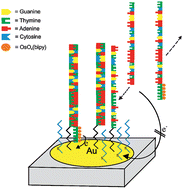In this report, we present sequence-specific DNA detection by means of a competitive hybridization assay with osmium tetroxide-labelled signalling strands. The labelling of the signalling strands has been performed using protective strands to preserve the recognition site of these single strands for hybridization with the immobilized capture probes. At optimized measuring conditions and especially assay temperature, we could detect the presence of 25 nM target DNA within 30 minutes, whereas the non-complementary target sequence did not yield any signal. The latter was observed as a decrease in square-wave voltammetric response of the signalling probes. Single base mismatches could be detected at a stringent 35 °C electrolyte temperature. Moreover, the concentration dependency of the signal was investigated. A time-consuming labelling procedure of the target, as typically used before, is not necessary. Upon application of the new protocol, there is no need for handling osmium(VIII) compounds during sample treatment. The signalling strands containing Os(VI) are prepared separately and can be stored over several months.

You have access to this article
 Please wait while we load your content...
Something went wrong. Try again?
Please wait while we load your content...
Something went wrong. Try again?


 Please wait while we load your content...
Please wait while we load your content...